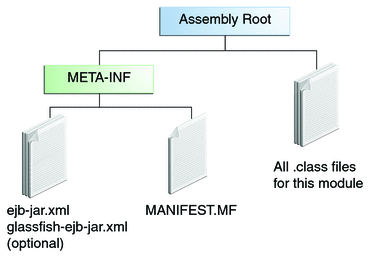The Contents of an Enterprise Bean (original) (raw)
2. Using the Tutorial Examples
3. Getting Started with Web Applications
4. JavaServer Faces Technology
7. Using JavaServer Faces Technology in Web Pages
8. Using Converters, Listeners, and Validators
9. Developing with JavaServer Faces Technology
10. JavaServer Faces Technology: Advanced Concepts
11. Using Ajax with JavaServer Faces Technology
12. Composite Components: Advanced Topics and Example
13. Creating Custom UI Components and Other Custom Objects
14. Configuring JavaServer Faces Applications
16. Uploading Files with Java Servlet Technology
17. Internationalizing and Localizing Web Applications
18. Introduction to Web Services
19. Building Web Services with JAX-WS
20. Building RESTful Web Services with JAX-RS
21. JAX-RS: Advanced Topics and Example
What Is a Message-Driven Bean?
What Makes Message-Driven Beans Different from Session Beans?
When to Use Message-Driven Beans
Using Enterprise Beans in Clients
Deciding on Remote or Local Access
Accessing Local Enterprise Beans Using the No-Interface View
Accessing Local Enterprise Beans That Implement Business Interfaces
Naming Conventions for Enterprise Beans
The Lifecycles of Enterprise Beans
The Lifecycle of a Stateful Session Bean
The Lifecycle of a Stateless Session Bean
The Lifecycle of a Singleton Session Bean
The Lifecycle of a Message-Driven Bean
Further Information about Enterprise Beans
23. Getting Started with Enterprise Beans
24. Running the Enterprise Bean Examples
25. A Message-Driven Bean Example
26. Using the Embedded Enterprise Bean Container
27. Using Asynchronous Method Invocation in Session Beans
Part V Contexts and Dependency Injection for the Java EE Platform
28. Introduction to Contexts and Dependency Injection for the Java EE Platform
29. Running the Basic Contexts and Dependency Injection Examples
30. Contexts and Dependency Injection for the Java EE Platform: Advanced Topics
31. Running the Advanced Contexts and Dependency Injection Examples
32. Introduction to the Java Persistence API
33. Running the Persistence Examples
34. The Java Persistence Query Language
35. Using the Criteria API to Create Queries
36. Creating and Using String-Based Criteria Queries
37. Controlling Concurrent Access to Entity Data with Locking
38. Using a Second-Level Cache with Java Persistence API Applications
39. Introduction to Security in the Java EE Platform
40. Getting Started Securing Web Applications
41. Getting Started Securing Enterprise Applications
42. Java EE Security: Advanced Topics
Part VIII Java EE Supporting Technologies
43. Introduction to Java EE Supporting Technologies
45. Resources and Resource Adapters
46. The Resource Adapter Example
47. Java Message Service Concepts
48. Java Message Service Examples
49. Bean Validation: Advanced Topics
50. Using Java EE Interceptors
51. Duke's Bookstore Case Study Example
52. Duke's Tutoring Case Study Example
53. Duke's Forest Case Study Example
To develop an enterprise bean, you must provide the following files:
- Enterprise bean class: Implements the business methods of the enterprise bean and any lifecycle callback methods.
- Business interfaces: Define the business methods implemented by the enterprise bean class. A business interface is not required if the enterprise bean exposes a local, no-interface view.
- Helper classes: Other classes needed by the enterprise bean class, such as exception and utility classes.
Package the programming artifacts in the preceding list either into an EJB JAR file (a stand-alone module that stores the enterprise bean) or within a web application archive (WAR) module.
Packaging Enterprise Beans in EJB JAR Modules
An EJB JAR file is portable and can be used for various applications.
To assemble a Java EE application, package one or more modules, such as EJB JAR files, into an EAR file, the archive file that holds the application. When deploying the EAR file that contains the enterprise bean’s EJB JAR file, you also deploy the enterprise bean to the GlassFish Server. You can also deploy an EJB JAR that is not contained in an EAR file. Figure 22-2 shows the contents of an EJB JAR file.
Figure 22-2 Structure of an Enterprise Bean JAR

Packaging Enterprise Beans in WAR Modules
Enterprise beans often provide the business logic of a web application. In these cases, packaging the enterprise bean within the web application’s WAR module simplifies deployment and application organization. Enterprise beans may be packaged within a WAR module as Java programming language class files or within a JAR file that is bundled within the WAR module.
To include enterprise bean class files in a WAR module, the class files should be in the WEB-INF/classes directory.
To include a JAR file that contains enterprise beans in a WAR module, add the JAR to the WEB-INF/lib directory of the WAR module.
WAR modules that contain enterprise beans do not require an ejb-jar.xml deployment descriptor. If the application uses ejb-jar.xml, it must be located in the WAR module’sWEB-INF directory.
JAR files that contain enterprise bean classes packaged within a WAR module are not considered EJB JAR files, even if the bundled JAR file conforms to the format of an EJB JAR file. The enterprise beans contained within the JAR file are semantically equivalent to enterprise beans located in the WAR module’sWEB-INF/classes directory, and the environment namespace of all the enterprise beans are scoped to the WAR module.
For example, suppose that a web application consists of a shopping cart enterprise bean, a credit card processing enterprise bean, and a Java servlet front end. The shopping cart bean exposes a local, no-interface view and is defined as follows:
package com.example.cart;
@Stateless public class CartBean { ... }
The credit card processing bean is packaged within its own JAR file,cc.jar, exposes a local, no-interface view, and is defined as follows:
package com.example.cc;
@Stateless public class CreditCardBean { ... }
The servlet, com.example.web.StoreServlet, handles the web front end and uses both CartBean andCreditCardBean. The WAR module layout for this application looks as follows:
WEB-INF/classes/com/example/cart/CartBean.class WEB-INF/classes/com/example/web/StoreServlet WEB-INF/lib/cc.jar WEB-INF/ejb-jar.xml WEB-INF/web.xml
Copyright © 2013, Oracle and/or its affiliates. All rights reserved. Legal Notices


